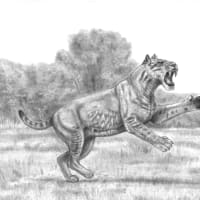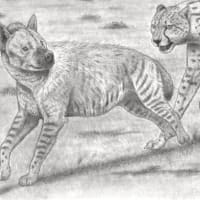Thunder Beast or Giant Unicorn : Who's the runner-up?
the Saber Panther
I've been wondering for sometime, which species was actually the second largest after Paraceratherium transouralicum(and some other super sized forms of indricothere) in the history of perissodactyla.
The middle Pleistocene giant unicorn rhino, Elasmotherium(E. sibiricum or E. caucasicum) is often quoted as one of the largest members of the rhinocerotoidea, perhaps second only to Paraceratherium in size among the entire group. Caucasian and siberian Elasmotherium specimens were indeed humongous, quoted as being over 4.5 m in body length, and over 2 m tall at the shoulders(Zhegallo et al., 2005), thus considerably outsizing the contemporaneous woolly rhinoceros and the extant white rhinoceros. These great ancient rhinos are estimated by some people to have almost matched the woolly mammoth in body mass, perhaps weighing an excess of 4 tons.
However, if there were other perissodactyls that could compete with the giant unicorn for the honorable 'runner-up' placing among the order, that must have been brontotheres, also known as 'thunder beasts'. Being the uncontested largest terrestrial mammals in the Eocene epoch, most known brontotheres were super sized and several species are quoted as reaching unbelievable 2.5 m at the shoulders.
While the claim rings a bit exaggerated, the picture below of a skeleton of Megacerops sp., one of the largest brontotheres, certainly substatiates the claim that they were absolutely super sized perissodactyls. This specimen appears utterly monstrous, incredibly tall and overall more ponderous, especially so at the limbs than does a skeleton of Elasmotherium sp.
A Megacerops' skull I saw at the Ueno Nature and Science Museum was also huge.
The above mentioned Megacerops specimen is still on display at the American Museum of Natural History, New York, being labeled(erroneously, perhaps) as Brontops robustus.
Is there anyone who has been there and saw the specimen?
Judging from these pictures at hand, this specimen seems easily exceeding 6'11"(2.1 m) in height, around 16 feet(4.9 m) or so in body length, in other words being every inch true to the popularly circulated brontothere measurements. The distal limbs look to be proportionally shorter for such tall stature, more graviportal than does the limbs of Elasmotherium, probably reflecting different ecological adaptation. After all they were not dubbed as 'elephant sized perissodactyls' for nothing.
It's got to be the case that some species of the largest known brontothere genera (Megacerops, Embolotherium or Rhinotitan) were at least comparable to the size of the largest Elasmotherium and accordingly, often quoted body mass estimation of 3 something tons sounds to me a bit too conservative compared to the case of Elasmotherium.
If you have any experience of seeing the skeletons of these behemoths in person, the skeletal measurement data or photos of them taken from similar angles(for better comparison) etc..., please share them with me, that would be awesome! I'd like to see the image of Elasmotherium skeleton with humans similarly compared as in the Megacerops picture.
Which one do you think must have been the second largest perissodactyl ever?
Megacerops sp.
American Museum of Natural History
(Image : パブリック・ドメイン)
A skull of Megacerops exibited at the Ueno nature and science museum
(Image : the Saber Panther)
Elasmotherium caucasicum
Azov historical and archaeological and paleontological museum-reserve
(Image : ウィキメディア・コモンズ)



















※コメント投稿者のブログIDはブログ作成者のみに通知されます